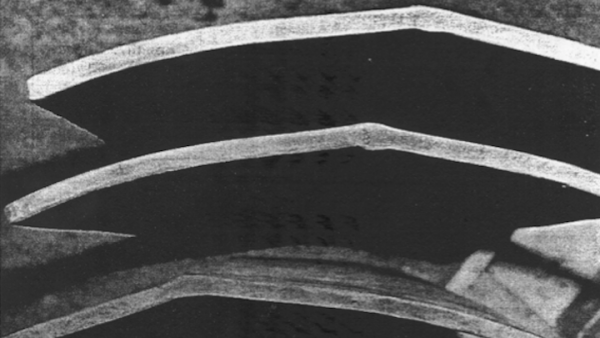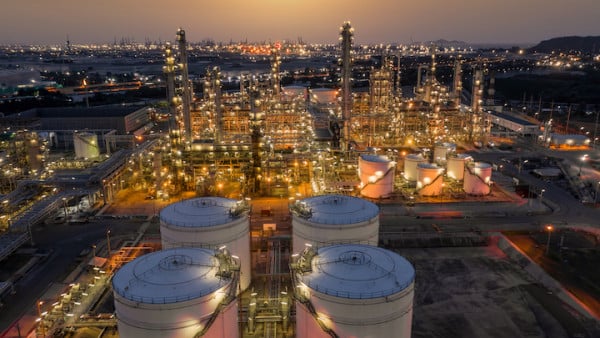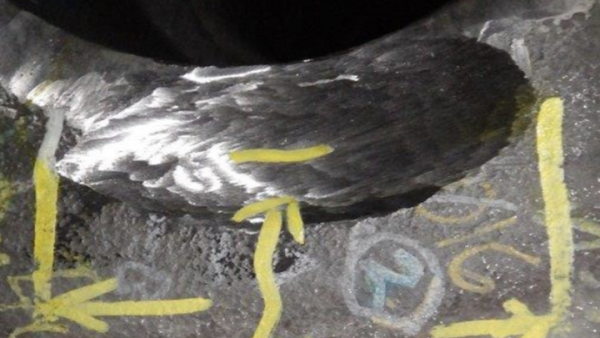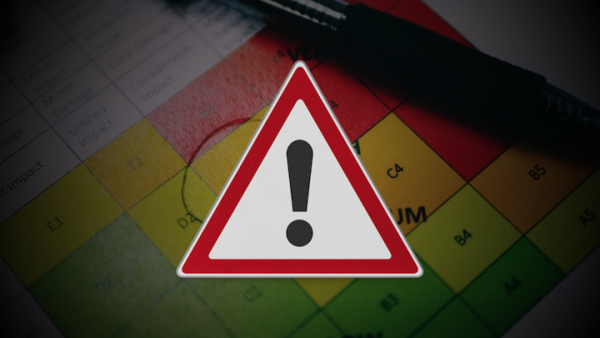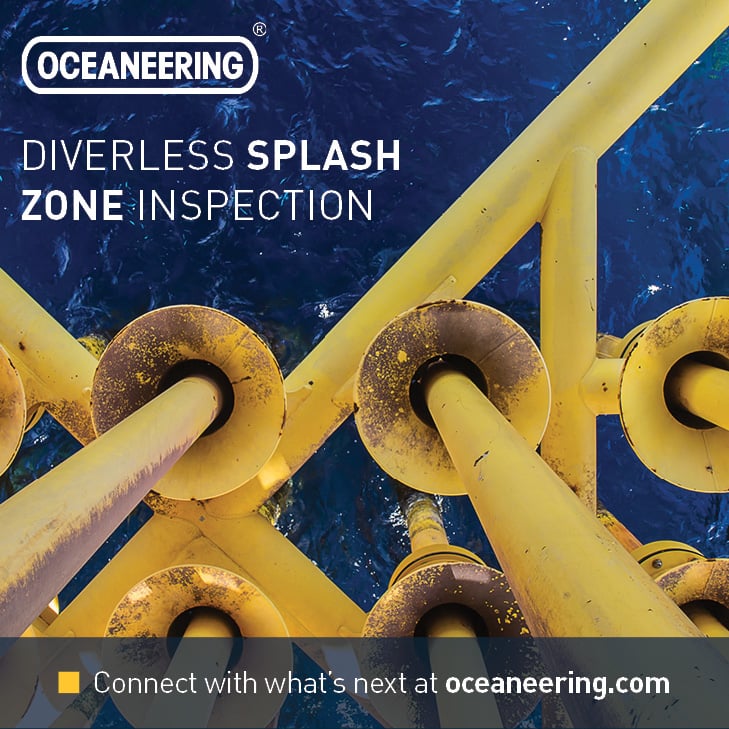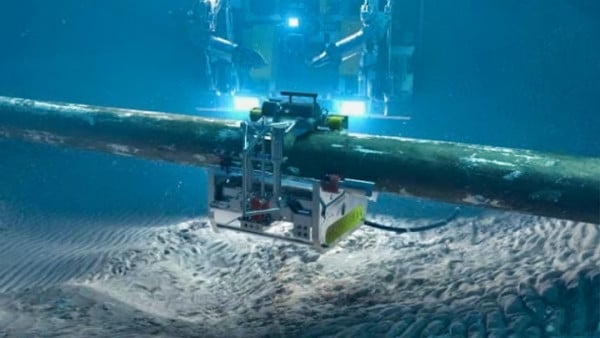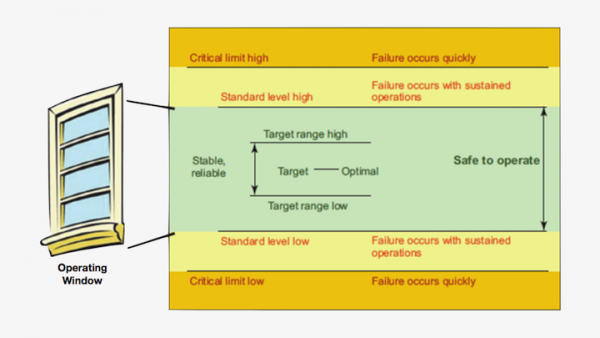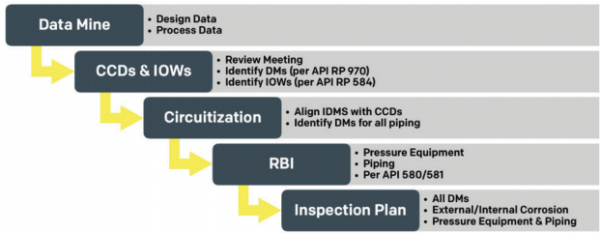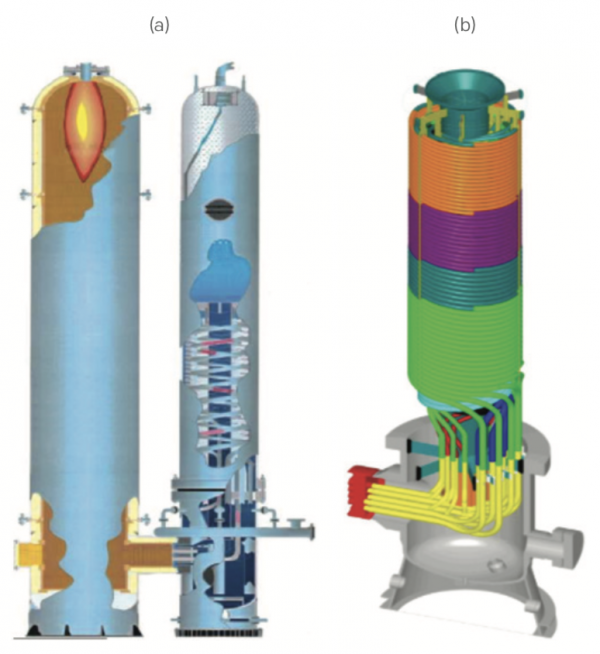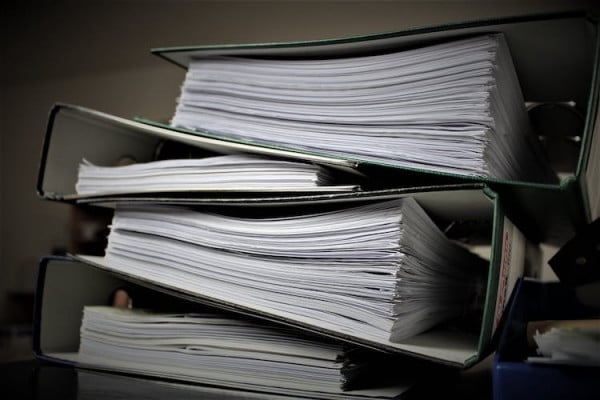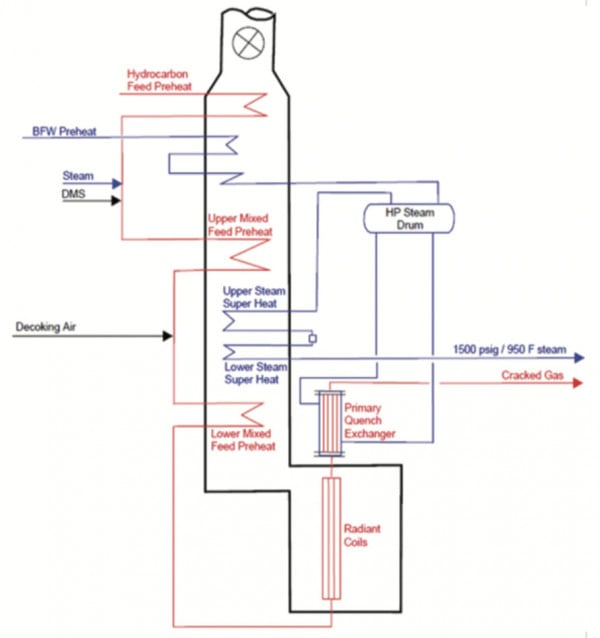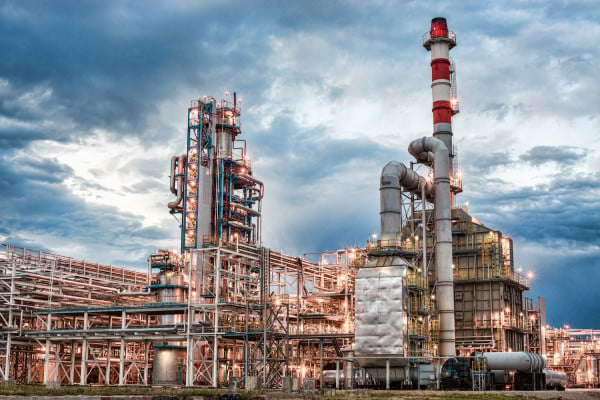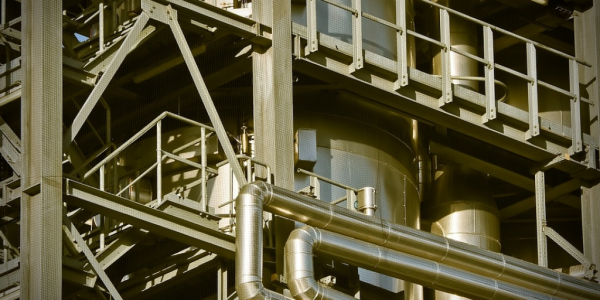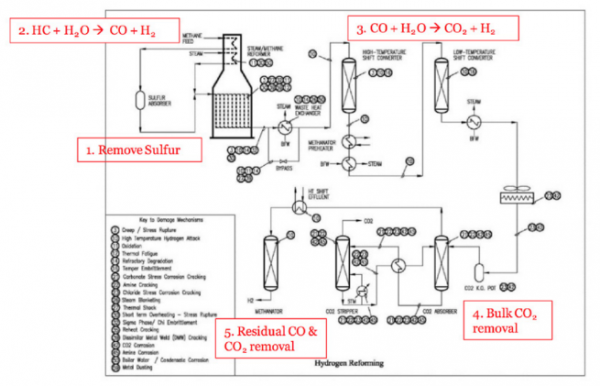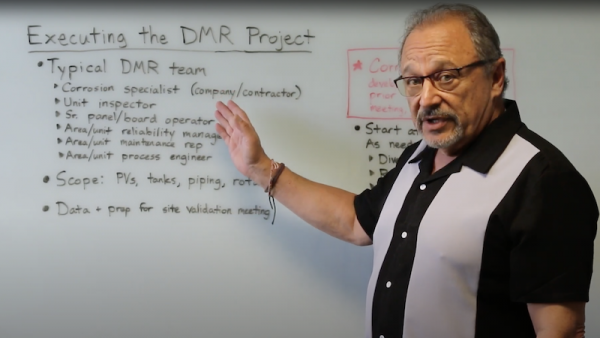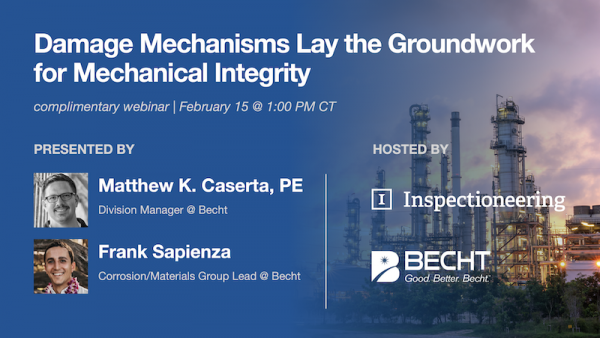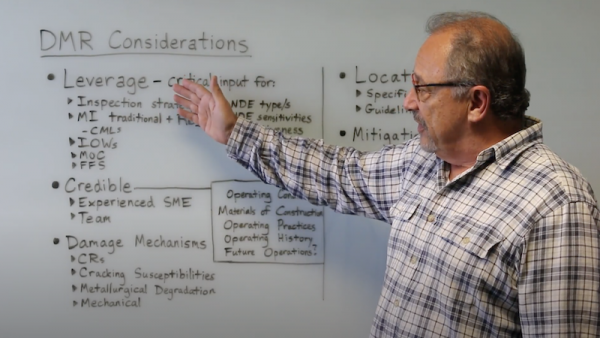A Damage Mechanism Review (DMR) is a systematic evaluation process used to identify credible damage mechanisms that can affect assets in industrial facilities, particularly in the context of corrosion, cracking, and material degradation. A DMR is one part of a comprehensive inspection program. It may be done as part of a traditional inspection program or to identify and assess the risks associated with various damage mechanisms, helping to ensure the integrity and safe operation of equipment. A good understanding of reasonably anticipated or potential damage mechanisms is critical when developing mechanical integrity (MI) programs and establishing inspection plans, including condition monitoring locations (CMLs). Damage mechanism reviews are also an important part of management of change (MOC) reviews and performing process hazard analysis (PHA) studies.
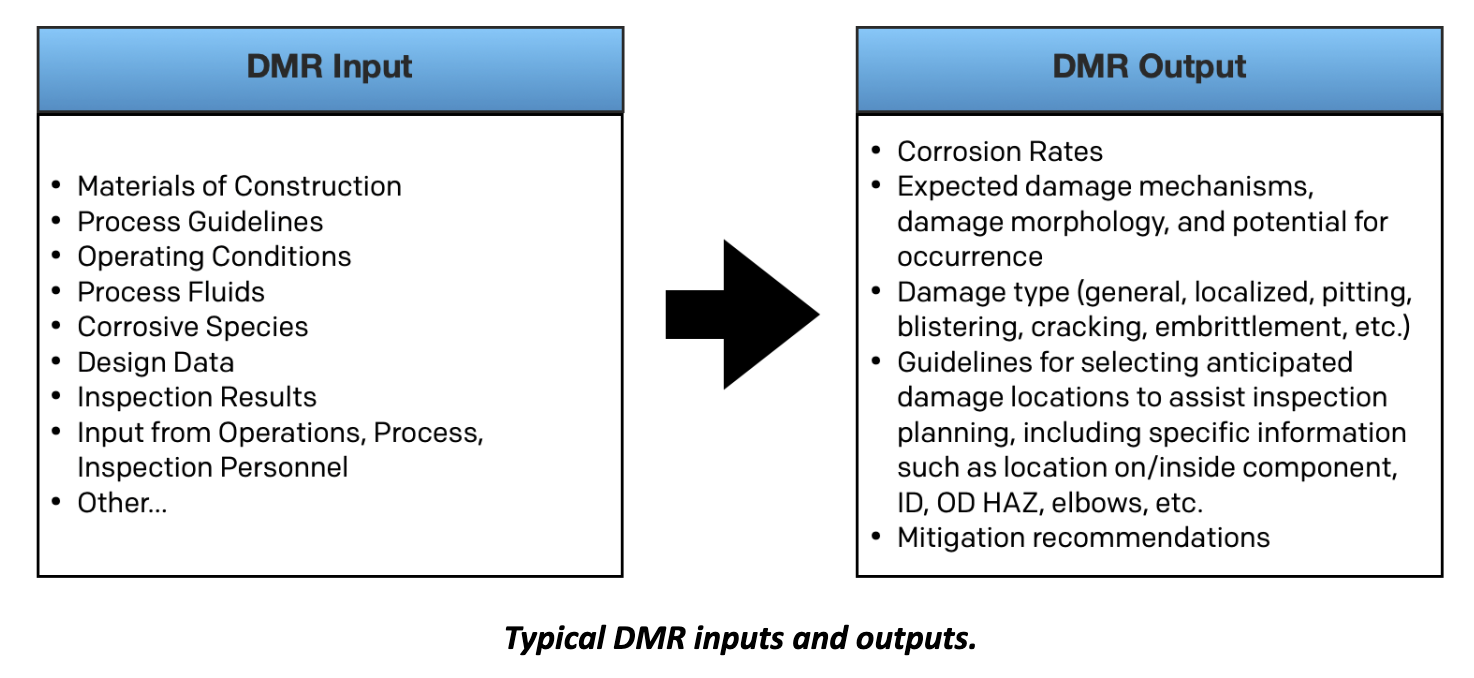
Who should be involved in a Damage Mechanism Review?
A DMR should involve a cross-functional team with knowledge of and experience with the unit and the particular process and equipment under consideration. This team should include personnel with expertise in the following areas, as appropriate:
- Inspection
- Maintenance
- Operations
- Process Safety
- Corrosion/Materials Engineering
- Reliability Engineering
- Process Engineering
What should be addressed in a Damage Mechanism Review?
The DMR team should identify and consider the following when conducting a damage mechanism review:
- The level at which the DMR is being performed (e.g., PFD or P&ID);
- The types of equipment subject to the DMR (e.g., pressure vessels, heat exchangers, bundles, piping, pumps, turbines, compressors, etc.), including their location and function;
- All relevant documentation, including design specifications, inspection histories, maintenance records, and any previous assessments related to corrosion and material degradation;
- All credible, potential damage mechanisms for the specific equipment in scope, including any mechanical and metallurgical damage, uniform or localized thickness loss, high-temperature corrosion, and cracking;
- The locations damage is likely to occur in the equipment (e.g., elbows, areas of low flow, vapor space, liquid space, welds, HAZs, etc.);
- What is creating the damage and “driving” the damage rates (e.g., operating parameters, chemistry, environmental conditions, etc.);
- The materials of construction and whether they are appropriate for their intended use and resistant to potential damage mechanisms;
- The inspection and monitoring methods used to detect and assess damage mechanisms;
- With a little additional effort, Integrity Operating Window parameters may also be identified during this effort.
How to Conduct a Damage Mechanism Review
The following 6 steps should be a part of any damage mechanism review:
- Define the Scope - clearly define the scope and objectives of the DMR, including identifying the unit, equipment, and/or corrosion circuit to be assessed and the intended outcome.
- Form the DMR Team - assemble a multidisciplinary team of experts, including corrosion engineering, unit inspectors, materials specialists, and maintenance personnel.
- Collect and Review all Relevant Data - gather all relevant data, documents, and historical records pertaining to the equipment, including materials of construction, design specifications, and operating conditions.
- Identify Potential Damage Mechanisms - generate a list of potential damage mechanisms based on available information and industry knowledge.
- Develop and Recommend Mitigation Measures - develop and recommend mitigation measures for each damage mechanism, as desired. These may include material upgrades, corrosion inhibitors, new inspection strategies, or changes in operating practices and/or parameters.
- Prepare Detailed DMR Report - prepare a comprehensive DMR report detailing the entire process and its findings.
NOTE: If you’ve implemented risk-based inspection (RBI) at your facility, the DMR process might also include the following additional steps:
- Conduct Risk Assessment - evaluate the identified damage mechanisms in terms of probability of failure and consequences of failure using quantitative and/or qualitative methods.
- Prioritize Damage Mechanisms - rank and prioritize the damage mechanisms based on their risk levels, focusing on those with the highest risk factors.
How to Prepare a DMR Report
Once the damage mechanism review is complete, a written report should be prepared for all key stakeholders. This DMR report serves as a valuable tool for your facility’s decision-makers, helping them make better-informed choices about inspection, maintenance, repair, replacement, and risk management to ensure the continued safe and efficient operation of your equipment. A DMR report should, at a minimum, include the following 9 things:
- Executive Summary: In this section, you should provide a concise overview of the DMR, its purpose, any major findings, who was involved, and any important recommendations.
- Scope and Objectives: In this section, you should clearly define the scope and specific objectives of the DMR, including any background information on the equipment and its significance, process descriptions, process drawings, etc.
- Data Assessed: In this section, you should provide a description of the data sources and all documents reviewed during the assessment.
- Credible Damage Mechanisms Identified: In this section, you should list out all of the credible, potential damage mechanisms identified during the review with inspection location guidance (DO NOT SKIP THIS STEP).
- Updated PFDs and P&IDs: In this section, you should include PFDs and P&IDs illustrating the identified damage mechanisms and rates, typically at the PFD or loop level, or at the P&ID (circuit) level, as appropriate.
- Mitigation Measures: In this section, you should provide any recommendations for temporarily and permanently mitigating or preventing damage mechanisms, as desired, along with associated cost and timeline estimates.
- Key Findings: In this section, you should summarize the key findings and their implications for the integrity of the equipment under review.
- Appendices: In this section, you should include any supplementary information, such as technical data, calculations, and supporting documentation.
- References: In this section, you should provide citations for any codes, standards, or reference materials used in the DMR.
Evergreening and Updating DMRs
Once a damage mechanism review is complete and all of the data is validated, you should now have a high fidelity list of data that is organized effectively and efficiently for creating inspection and equipment integrity strategies. You should also have a DMR report containing:
- Narratives on each corrosion loop, created by the corrosion engineer and validated by the DMR team, highlighting the issues within those loops and how to resolve them, representative circuits where that level of detail is justified, issue drivers, descriptions of where to expect the damage in the part, how it will look, and where to look – thus enabling the creation of high quality inspection and equipment strategies. This should also include recommendations for IOWs, and any pertinent comments regarding things like water treatment, chemical treatment, and external issues (e.g., CUI and external cracking).
- Recommendations for damage mitigation and inspection strategies.
- PFDs documenting:
- Corrosion loops
- Materials of construction
- Damage types and locations
It is important to remember that damage mechanism reviews are not a “one and done” exercise. Things are constantly changing in our facilities; operating practices may be modified, feedstocks may be altered, parts of the design may change, expansion projects may occur, pieces of equipment may leak or fail unexpectedly, operating conditions may change, the unit may run in more severe conditions, repairs may be performed, and so on. In fact, some jurisdictions require petroleum refineries to perform DMRs on their processing units and conduct re-evaluations of the DMRs on frequencies not to exceed the operators’ PHA/HAZOP schedule for that unit.
The reason DMRs need to be periodically re-evaluated is that things can change, and this holds true for all operating facilities. Not to be overlooked either are operating practices. Most agree that if everyone operated their units as they were designed to operate, we would not have many of the leaks we experience. So we need to pay special attention to what happens “in the middle of the night” as far as operating excursions outside of reliable operating limits.
Regulatory updates, new industry experiences, changes in IOWs, exceedances, expansions, changes in catalysts, etc. may require an updated or new DMR, as appropriate.
References
- Alvarado, G., 2019, “There’s Gold in Those Damage Mechanism Reviews,” Inspectioneering Journal, Spring, Texas, 25(5), pp. 22-27.
- API Recommended Practice 571, “Damage Mechanisms Affecting Fixed Equipment in the Refining Industry,” 3rd Edition, March 2020, American Petroleum Institute, Washington D.C.
- Penuela, L. and Zaman, V., 2019, “Managing Reliability of Ethane Crackers using DMR, RBI, and IOWs,” Inspectioneering Journal, Spring, TX, 25(3), pp. 20-30.
Relevant Links
Topic Tools
Share this Topic
Contribute to Definition
We welcome updates to this Integripedia definition from the Inspectioneering community. Click the link below to submit any recommended changes for Inspectioneering's team of editors to review.
Contribute to Definition


